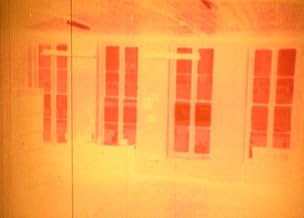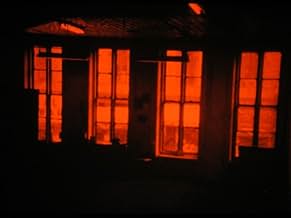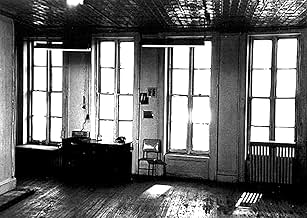Adicionar um enredo no seu idiomaClaimed by some to be one of the most unconventional and experimental films ever made, Wavelength is a structural film of a 45-minute long zoom in on a window over a period of a week. Very u... Ler tudoClaimed by some to be one of the most unconventional and experimental films ever made, Wavelength is a structural film of a 45-minute long zoom in on a window over a period of a week. Very unconventional and experimental, indeed.Claimed by some to be one of the most unconventional and experimental films ever made, Wavelength is a structural film of a 45-minute long zoom in on a window over a period of a week. Very unconventional and experimental, indeed.
- Prêmios
- 1 vitória no total
Avaliações em destaque
The forty-five minute long work is a single scene of a room, experimented with using various color filters, slowly and gradually zooming in to a photo on the wall of the room. Very little occurs onscreen except for the zoom, and in many ways it is really a series of film variations on the only focal point. That's not to say there is no onscreen action though; traffic can be seen occasionally moving outside the windows of the room, several women enter early on whilst a Beatles song is played, and the climax is a series of loud banging noises--as though a burglary is happening offscreen--before the great experimental filmmaker Hollis Frampton enters the shot and falls dead to the floor.
One other reviewer has interpreted that the film's goal is that to have almost nothing happen the viewer gets to appreciate more what does happen, and this is a very good point. In either case, it is a very interesting and abstract experimental work, as well as the ending which does a quite literal turn on the title, and an absolute must for fans of experimental cinema. It's boring only if you look at it as a scene of a room; it becomes interesting when you delight in the moments of action and I really liked it because it kept my interest despite the lack of events. I found that when watching it it was not a painfully boring watch like many say, because after a while you accept nothing big is going to happen and let the movie play out as it is. To be constantly bored at a movie for an entire forty-five minutes is quite unnatural, at least for me.
Like Hollis Frampton's ZORNS LEMMA, WAVELENGTH is the kind of picture made to be written about, not really endured. The glowing descriptions of it in critics' prose are more provoking than the actual artifact itself. Two things remain striking and puzzling about it thirty-two years later. Why did Snow choose to make a near-hour-long demonstration of the zoom lens? Why would tracking have been any different--is the movie meant to be a statement on a subjective appearance of changed perspective, while the viewer really remains static? Or was Snow just infatuated with the gimmickry of the zoom? (Each calibration churning closer to the photograph has a home-movie clunkiness.)
The other is the oddly hippie-dippie tone of Snow's inserted gimcrackery. From the charwoman-looking extra playing "Strawberry Fields Forever" on a radio, then lumbering off like a bit player in an Ed Wood number, to the acid-flashback reruns of just-passed scenes, to the freak colorizations of arbitrary moments (as if we jumped to the POV of a UFO), the ambience is much more Big Brother and the Holding Company than Robert Bresson. It's the same playing-with-a-gizmo amateurism that mars the images using people in Stan Brakhage's DOG STAR MAN, and it makes Snow's academic astringency look like a pose.
(WAVELENGTH showed up again, ripped off in the unlikeliest place: the track into a photograph that forms the "Twilight Zone" epilogue to Kubrick's THE SHINING.)
Yet it holds value to many others in its artistic nature. Sadly as I failed to consciously view most of it I can only give short and brief opinion on it as a good sleep aid.
Nothing could be further from the truth, though. Good art requires that meaning be contained within the text. Events take place; people say things -- those should be the very basic requirements for art. The tools of cinema -- editing, camera placement and movement, and so forth -- are important, but alone, don't cut it. A mere, 'cool' concept doesn't suffice. So skip the earth-shattering, condescending, pretension of Wavelength -- and its musical analogue in the "compositions" (I use that phrase lightly) of John Cage -- and instead look elsewhere, in films and works that seek to communicate real ideas about human experience. If you do feel a need to profess a real knowledge of "art," watch Bergman's "Wild Strawberries," or Fellini's "8 1/2." Heck, rent "E.T." for goodness sake. But please don't be fooled by by this junk.
Você sabia?
- CuriosidadesMichael Snow has stated that his intent with the film was for it to be "a summation of my nervous system, religious inklings and aesthetic ideas."
- Citações
Woman in fur coat: I just got here, and there's a man lying on the floor, and I think he's dead.
- ConexõesEdited into WVLNT: Wavelength For Those Who Don't Have The Time (2003)
Principais escolhas
Detalhes
- Tempo de duração45 minutos
- Cor
- Proporção
- 1.37 : 1
Contribua para esta página


















